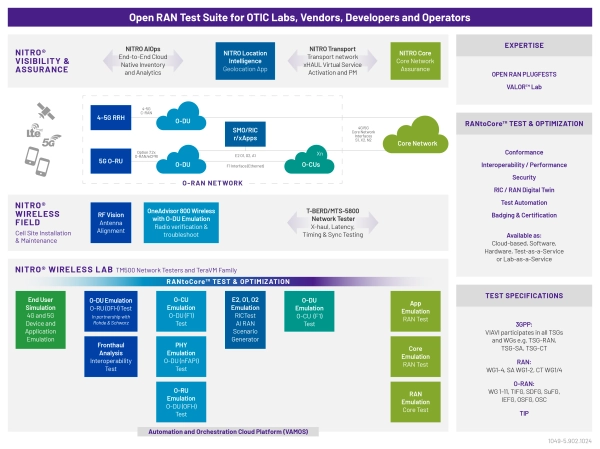RAN Intelligence Solutions
AI RAN Scenario Generator and Geolocation
At VIAVI, we offer the most comprehensive testing & training suite for O-RAN RIC and x/rApps, including our RAN Scenario Generator for AI app training.
This makes us the perfect partner for your NTIA NOFO 3 funding application process. Whether you’re developing or deploying RIC or x/rApps, collaborate with us to ensure you’re fully prepared for field deployment.
Reducing total cost of ownership for next-generation Radio Access Networks requires a higher level of network intelligence. This is achievable with a well-tested and optimized RIC combined with innovative r/xApps.
Energy costs have become a major concern with operators facing a double hit from higher price per megawatt and new technologies that consume more power such as Massive MIMO. Moreover, with increased competition and slowing growth in subscriber numbers, operators must find ways to reduce TCO and achieve a positive ROI for 5G upgrades faster.
Defining RAN Intelligence
RAN intelligence is composed of the RAN Intelligent Controller (RIC), third-party r/xApps, and data analytics. All these elements build an interactive brain that enables a self-learning, optimized, and efficient AI/ML-driven wireless network.
Feeding Intelligence in the RIC
The RAN Intelligent Controller (RIC) acts as a "cognitive enhancer" in the Open RAN architecture. Through third-party r/xApps that use AI/ML algorithms, it gathers and analyzes live feeds from the network, historical data, and trends to predict what may happen in the RAN, then very quickly adjusts parameters for optimal performance. It enables Operators to:
- Save energy use
- Protect network slices and guarantee SLAs
- Optimize spectrum resources to get more calls and data sessions
- Improve Customer Experience
- Anticipate and mitigate issues before they happen
- Automate main operations from network configuration to optimization
- Detect security breaches early and close the door on the breach before it spreads into the network
Boost the RAN Intelligence
The RIC is a brand-new node with new interfaces and r/xApps from different developers. If it doesn't work properly and securely, it can lead to network degradation and security breaches.
Before the RIC is implemented in a live network, Operators, Network Equipment Manufacturers and r/xApp developers must therefore understand and validate the dynamics between the platform and the Apps.
A thoroughly tested and optimized RIC, along with first-class r/xApps will enhance the RAN intelligence and facilitate the confident roll-out of Open RAN and new architectures
AI RAN Scenario Generator (AI RSG) for Operators, Network Equipment Manufacturers and r/xApp developers
The VIAVI AI RAN Scenario Generator (AI RSG) solution recreates the volume, scale, and types of messages moving across the O1, A1, E2 interfaces interface in real-world networks.
RAN Scenario Generation also provides an ideal vehicle for r/xApp training and interoperability testing between multi-vendor O-DU, O-CU, and RIC network elements. The App Validation Engine (AVE) acts as an App "IQ test" to validate if the proposed changes improve RAN efficiency, with no performance impact. In an easy, cost-effective way.
Click on the areas below to learn more:
Does E2 implementation perform according to O-RAN Alliance standards. Measure metrics such as:
- How many SCTP Links from O-CU/O-DU to RIC
- How many TPS per E2 interface
- How many RICs for a large MNO network
- How many E2 set up messages per second
- How many UE reports generated per second
r/xAPP Functionality Testing, which establishes how effective are the decisions taken by the r/xAPPs housed on the Near RT RIC. The system measures the effectiveness of r/xAPP recommendations by performing the changes in the emulated RAN, and measuring the change over time to see if the desired improvement is achieved. Areas addressed, but not limited to, are:
- Traffic steering;
- Anomaly detection and mitigation;
- Geolocation r/xApp;
- Energy Saving,
- Network slice QoS assurance.
Since messages coming into the RIC need to go over the E2 interface, testing the RIC often requires an emulated network. TeraVM emulates the RAN and its traffic scenarios to stress-test the RIC and identify security vulnerabilities before live deployment. In addition, the risk of malicious Apps that could infect or compromise the network is high. It is important to audit and test all third-party Apps before integrating them into the RIC.
Mutual authentication (or Zero-trust) is used in the RIC to safeguard against breaches and malicious components, but this must be tested to confirm authentication processes are correctly blocking malicious traffic.
AI RAN Scenario Generator enables r/xApps to train their algorithms under different scenarios for a complete and all-round RAN experience. With TeraVM AI RAN scenario generator you can emulate traffic scenarios and push them to the r/xApps for a diverse set of UE behaviors and traffic models. This process will expose the r/xApps to the myriad of RAN scenarios it will encounter in Live mode and will train the r/xApp before actual deployment. RAN Scenarios that can be generated:
- RF/performance anomaly simulations
- Mobility pattern simulations
- RF propagation models including pathloss model, indoor/outdoor user pattern emulation
- Fading (shadow, fast)
Create a virtual environment with buildings, base stations, moving cars, and more. This setup simulates a reliable, scalable, and trusted real-life RAN, generating countless scenarios to fully train and test AI/ML optimization algorithms.
Enhance your RAN Scenario Generation with network realism by incorporating real network traffic patterns and KPIs. This will create a more realistic dataset, reflecting an operator’s network as a Digital Twin.
VIAVI geolocation enablement for r/xApps
Upon deployment, location intelligence provides valuable information about the geographical distribution of network traffic, user behavior, and network performance. When applied to next generation radio networks, geolocation insight is a must to improve decision-making of RIC applications.
VIAVI Geolocation is a foundational component of the RIC that exposes geolocated data to r/xApps, including 24/7 insights on spatial distribution and mobility dynamics of subscribers. It gives unique visibility on devices, network and service performance and it provides context-aware insights that help RIC Apps make better decisions in multiple Near-RT and Non-RT optimization use cases.
By accessing user location and behavior, the App algorithms can:
- dynamically allocate capacity
- adjust frequency bands
- optimize network parameters to meet changing conditions and user demands
- reduce the overall energy consumption
The VIAVI Geolocation technology for the RIC allows the next generation RAN to be more agile, and deliver higher customer experience with less energy and reduced operational costs.
The VIAVI Difference
There's still plenty of industry learning to be achieved, but VIAVI already has the right solutions and expertise to help you boost the RAN Intelligence.
Pivotal Contributions
We participate in the O-RAN ALLIANCE working groups to define RIC standards and we have regular engagement with the O-RAN OSC vendor community.
O-RAN Plugfests
VIAVI conducted conformance, performance, and End-to-End (E2E) interoperability testing at the 2021/2022/2023 Global O-RAN PlugFests. We demonstrated near real-time RIC platform conformance test and r/xApp performance benchmarking with RIC and r/xApps supplied by Nokia, TIM, Capgemini, HCLTech, NEC.
Partnership
We have partnered with VMWare to standardize RIC testing frameworks, "testbed as a service" platforms, and test metrics.
Successful Integration
VIAVI Location Intelligence r/xApp was successfully integrated with industry leading RICs and SMOs, including the VMWare Distributed RIC.
Demonstrations
At MWC23, VIAVI demonstrated how AI RAN Scenario Generator (AI RSG) can be used to train AI/ML models underpinning r/xApps to deliver 10-20% energy savings without negatively impacting QoS.
AWS Marketplace Approval
AI RAN Scenario Generator (AI RSG) is now available on AWS Marketplace.
ブログ
印刷物
ホワイトペーパーおよび書籍
VIAVIはお客様のためにあります
VIAVIはお客様の成功のお手伝いをします。







